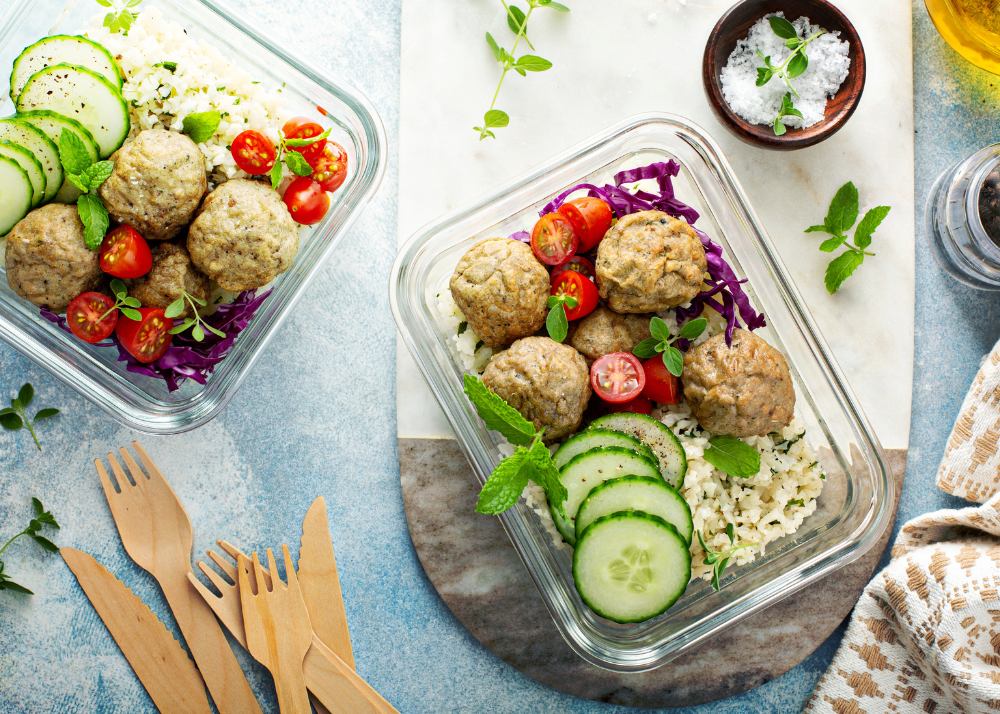Postpartum meal prep is one of the best ways to reduce stress, save time, and ensure new parents get the nourishment they need during recovery. From our experience as Registered Dietitians, having ready-to-eat meals on hand makes a huge difference in energy levels, healing, and overall well-being.
After putting it to the test, we know that the best meals are freezer-friendly, easy to reheat, and packed with essential nutrients like protein, fiber, and healthy fats. This guide covers everything from meal ideas and storage tips to essential postpartum foods and answers to common questions about prepping meals before birth.

Postpartum Meal Prep Ideas
Having a variety of ready-to-eat meals during the postpartum period makes life easier and recovery smoother. From our experience as Registered Dietitians, meals that are freezer-friendly, easy to reheat, and packed with essential nutrients are the most helpful.
Below are some of our favorite meal prep ideas, broken down into specific meals that are simple to prepare and store:
Freezer-Friendly Breakfast Burritos
Breakfast burritos are a great grab-and-go option that provides a balance of protein, fiber, and healthy fats. To make them, scramble eggs with your favorite add-ins like spinach, bell peppers, and cheese.
Add a protein source such as turkey sausage or black beans for extra staying power. Wrap the mixture in whole wheat tortillas, then individually wrap each burrito in foil before freezing. When ready to eat, reheat in the microwave or oven for a quick, satisfying meal.
Oatmeal Muffins With Bananas And Nuts
Oatmeal muffins are a great way to pack in fiber and complex carbohydrates, which help sustain energy levels throughout the day. Mash ripe bananas and mix them with rolled oats, eggs, almond milk, cinnamon, and chopped nuts.
Pour the batter into a muffin tin and bake until golden. Once cooled, store them in an airtight container or freezer bag. These muffins can be eaten cold or quickly warmed in the microwave.
Egg And Veggie Cups
Egg and veggie cups are a protein-packed option that’s easy to make in bulk, making them an excellent option for meal prep for weight loss on a budget. Whisk eggs with milk, then add diced vegetables like bell peppers, spinach, and onions. Pour the mixture into a greased muffin tin, sprinkle with cheese, and bake until set.
After cooling, store in a freezer-safe container. To reheat, microwave for 30-60 seconds, making them a convenient breakfast or snack.
Slow Cooker Chicken And Veggie Stir-Fry
This meal is perfect for postpartum meal prep because it’s easy to portion and reheat. Slice chicken breast and mix it with chopped vegetables like carrots, bell peppers, and broccoli. Add a simple sauce made of soy sauce, garlic, and ginger.
Freeze in a bag or container. When ready to eat, thaw overnight, then heat in a skillet or slow cooker and serve over rice or quinoa.
Hearty Lentil And Vegetable Soup
Soups are an excellent choice for postpartum recovery because they provide hydration and essential nutrients. A hearty lentil and vegetable soup is easy to make by simmering lentils, carrots, tomatoes, and leafy greens in a broth seasoned with garlic and herbs.

Once cooled, portion into individual containers and freeze. When reheating, add a little extra broth or water if needed.
Cheesy Chicken And Broccoli Casserole
Casseroles make for comforting, nutrient-dense postpartum meals. To make a cheesy chicken and broccoli casserole, cook shredded chicken and mix it with cooked rice, steamed broccoli, and a homemade cheese sauce.
Spread the mixture into a baking dish, top with a little extra cheese, and freeze in a foil pan. Bake from frozen at 350°F until heated through and bubbly.
Slow Cooker Pot Roast With Root Vegetables
A slow cooker pot roast is perfect for postpartum meal prep since it requires minimal effort. Place a beef chuck roast in the slow cooker with potatoes, carrots, onions, and a simple broth of garlic, herbs, and Worcestershire sauce.
Cook on low until tender, then portion into freezer bags. Reheat in the microwave or oven for a comforting and protein-rich meal.
Quinoa And Roasted Veggie Bowls
Quinoa bowls are nutrient-dense, versatile, and easy to prepare ahead of time. Roast a mix of vegetables such as zucchini, sweet potatoes, and bell peppers, then combine them with cooked quinoa and chickpeas.
Portion into meal prep containers and freeze. When ready to eat, simply thaw and enjoy as-is or add a protein like grilled chicken or tofu.
Hummus And Veggie Snack Packs
Prepping individual snack packs makes it easy to grab something healthy when hunger strikes. Portion hummus into small containers and pair it with pre-cut veggies like cucumbers, bell peppers, and carrots.
Store in the fridge or freeze hummus separately. This snack provides fiber, healthy fats, and protein in one easy-to-eat option.

Peanut Butter Energy Bites
Energy bites are a quick and healthy snack option, especially when you need a boost between meals. Combine rolled oats, peanut butter, flaxseeds, honey, and dark chocolate chips in a bowl.
Roll into small balls and freeze on a baking sheet before transferring to a storage container. These bites are great straight from the freezer and provide lasting energy.
Lactation Cookies With Oats And Flaxseeds
Lactation cookies are designed to support milk production while doubling as a delicious treat. Mix oats, flaxseeds, brewer’s yeast, almond butter, and dark chocolate chips into a dough, then bake until golden.
Store in an airtight container or freeze for later. These cookies are a nutrient-dense snack that supports postpartum recovery and breastfeeding.
Greek Yogurt And Granola Parfaits
Greek yogurt parfaits are a high-protein, probiotic-rich snack that supports digestion and gut health. Layer Greek yogurt with fresh or frozen berries and granola in small jars.
Store in the fridge for up to a few days or freeze yogurt separately and thaw before eating. This makes for a creamy, nutritious, and satisfying snack.
What Foods Should You Eat After Giving Birth?
Postpartum recovery requires nutrient-dense foods to help with healing, energy, and, if breastfeeding, milk production. According to our research, here’s what to prioritize:
Protein (lean meats, eggs, beans, tofu): Supports tissue repair and muscle recovery
Healthy Fats (avocado, nuts, seeds, olive oil): Essential for hormone balance
Iron-Rich Foods (spinach, red meat, lentils): Helps replenish lost blood stores
Whole Grains (brown rice, quinoa, oats): Provides sustained energy
Hydrating Foods (bone broth, soups, fruits): Supports digestion and hydration
Calcium and Omega-3s (dairy, fish, flaxseeds): Important for bone health and mental well-being

Eating a well-balanced diet filled with these nutrients can support a smoother recovery, improve energy levels, and help you feel your best during the postpartum period.
If you’re unsure how to build a meal plan that meets your unique needs, a women’s health dietitian from Berry Street can help with everything from pregnancy meal prep to postpartum meal prep. Connect with us to create a personalized 7-day postpartum meal plan designed to support your recovery, nourish your body, and fit your lifestyle.
How to Store Postpartum Prep Meals
Proper storage ensures meals stay fresh, safe, and delicious. After putting it to the test, here are our best storage tips:
Step 1: Cool Before Freezing
Allowing meals to cool completely before placing them in the freezer is essential for preventing condensation, which can lead to freezer burn and loss of flavor. Hot food placed directly into the freezer can also raise the overall temperature inside, potentially affecting other stored items.
To speed up the cooling process, spread food out on a baking sheet or transfer it into shallow containers. If you're storing soups or stews, consider placing the pot in an ice bath and stirring occasionally to help it cool faster. Proper cooling keeps your meals fresh and preserves their texture when reheated.
Step 2: Use Freezer-Friendly Containers
Choosing the right storage containers makes a big difference in maintaining food quality and maximizing freezer space, whether you’re doing postpartum meal prep or are following a women's meal plan for muscle gain. Glass containers with airtight lids work well for individual meal portions and are easy to reheat.

Silicone freezer trays are ideal for soups, stews, or sauces, allowing you to pop out portions as needed. Ziplock freezer bags are a space-saving option for pre-portioned meals, as they can be laid flat to freeze and then stacked neatly.
For casseroles and baked dishes, disposable aluminum trays make for an easy, no-cleanup option—just reheat and enjoy. Whatever container you choose, ensure it is labeled "freezer-safe" to prevent cracking or leakage.
Step 3: Label Everything
Labeling each container properly helps you stay organized and prevents confusion when it's time to reheat meals. Use a permanent marker or freezer labels to write the meal name, the date it was prepared, and clear reheating instructions.
This makes it easier to rotate meals and avoid letting food sit too long in the freezer. If you're prepping multiple portions of the same dish, adding portion size details (such as "serves 2" or "single portion") can be helpful.
For an extra level of organization, keep a freezer inventory list on your phone or a notepad to track what’s available and what needs to be eaten first.
Step 4: Portion For Convenience
Freezing meals in the right portion sizes makes defrosting and reheating much more convenient. Consider whether you'll be eating alone, with a partner, or feeding a whole family, and portion meals accordingly.
Single-serving portions are great for quick meals, while family-sized portions work well for larger meals that can be shared.
For soups and stews, freezing in individual servings allows for quick defrosting, while larger meals like casseroles can be portioned into squares or slices before freezing. This way, you only take out what you need, reducing waste and making mealtime stress-free.

Step 5: Reheat The Right Way
Reheating meals properly ensures they taste just as good as when they were first made. For soups and stews, defrost them in the refrigerator overnight and then heat them on the stovetop until warm, stirring occasionally.
Casseroles can go straight from the freezer to the oven—bake at 350°F (175°C) for 30-40 minutes or until heated through.
For burritos and sandwiches, microwaving them for 1-2 minutes works well, but using an air fryer at 350°F for 5-7 minutes gives them a crispy texture. Avoid reheating meals multiple times to maintain food quality and safety.
Conclusion
Postpartum meal prep is one of the best ways to make life easier after birth, providing nutritious, freezer-friendly meals that support recovery, energy, and overall well-being. Having a variety of breakfasts, lunches, dinners, and snacks ready to go means less stress and more time to focus on yourself and your baby.
From our experience as Registered Dietitians, the key to success is choosing meals that are easy to store, properly portioned, and simple to reheat. Following the right storage methods ensures your meals stay fresh and safe, giving you one less thing to worry about during the postpartum period.
If you’re looking for personalized nutrition support during this time, connect with a Registered Dietitian at Berry Street to create a postpartum plan that works for you.
Meal Prep for Postpartum (FAQs)
Why should I meal prep for the freezer?
Prepping meals ahead of time saves time, energy, and stress, ensuring you have nutritious meals ready to go when you need them most.
When should I start my postpartum meal prep?
The best time to start is 1-2 months before your due date. This allows you to prep meals while you still have energy and ensures food stays fresh.

How many meals should I prep for postpartum?
Aim for 15-20 meals to cover the first few weeks. If space allows, prepping up to a month’s worth can be a huge help.
What foods freeze the best?
Casseroles (baked ziti, lasagna, enchiladas)
Soups & Stews (lentil, chicken noodle, chili)
Burritos & Sandwiches (breakfast burritos, grilled chicken wraps)
Proteins (shredded chicken, meatballs, taco meat)
Baked Goods (muffins, lactation cookies, banana bread)













